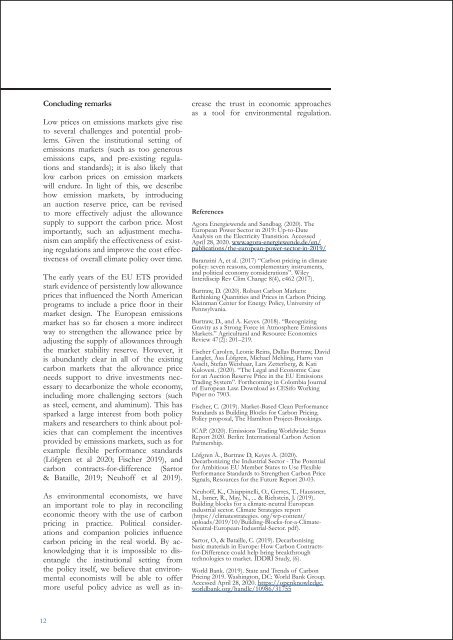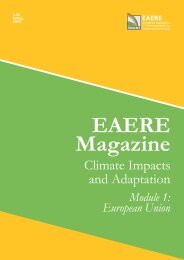Create successful ePaper yourself
Turn your PDF publications into a flip-book with our unique Google optimized e-Paper software.
Concluding remarks<br />
Low prices on emissions markets give rise<br />
to several challenges and potential problems.<br />
Given the institutional setting of<br />
emissions markets (such as too generous<br />
emissions caps, and pre-existing regulations<br />
and standards); it is also likely that<br />
low carbon prices on emission markets<br />
will endure. In light of this, we describe<br />
how emission markets, by introducing<br />
an auction reserve price, can be revised<br />
to more effectively adjust the allowance<br />
supply to support the carbon price. Most<br />
importantly, such an adjustment mechanism<br />
can amplify the effectiveness of existing<br />
regulations and improve the cost effectiveness<br />
of overall climate policy over time.<br />
The early years of the EU ETS provided<br />
stark evidence of persistently low allowance<br />
prices that influenced the North American<br />
programs to include a price floor in their<br />
market design. The European emissions<br />
market has so far chosen a more indirect<br />
way to strengthen the allowance price by<br />
adjusting the supply of allowances through<br />
the market stability reserve. However, it<br />
is abundantly clear in all of the existing<br />
carbon markets that the allowance price<br />
needs support to drive investments necessary<br />
to decarbonize the whole economy,<br />
including more challenging sectors (such<br />
as steel, cement, and aluminum). This has<br />
sparked a large interest from both policy<br />
makers and researchers to think about policies<br />
that can complement the incentives<br />
provided by emissions markets, such as for<br />
example flexible performance standards<br />
(Löfgren et al <strong>2020</strong>; Fischer 2019), and<br />
carbon contracts-for-difference (Sartor<br />
& Bataille, 2019; Neuhoff et al 2019).<br />
As environmental economists, we have<br />
an important role to play in reconciling<br />
economic theory with the use of carbon<br />
pricing in practice. Political considerations<br />
and companion policies influence<br />
carbon pricing in the real world. By acknowledging<br />
that it is impossible to disentangle<br />
the institutional setting from<br />
the policy itself, we believe that environmental<br />
economists will be able to offer<br />
more useful policy advice as well as increase<br />
the trust in economic approaches<br />
as a tool for environmental regulation.<br />
References<br />
Agora Energiewende and Sandbag. (<strong>2020</strong>). The<br />
European Power Sector in 2019: Up-to-Date<br />
Analysis on the Electricity Transition. Accessed<br />
April 28, <strong>2020</strong>. www.agora-energiewende.de/en/<br />
publications/the-european-power-sector-in-2019/<br />
Baranzini A, et al. (2017) “Carbon pricing in climate<br />
policy: seven reasons, complementary instruments,<br />
and political economy considerations”. Wiley<br />
Interdiscip Rev Clim Change 8(4), e462 (2017).<br />
Burtraw, D. (<strong>2020</strong>). Robust Carbon Markets:<br />
Rethinking Quantities and Prices in Carbon Pricing.<br />
Kleinman Center for Energy Policy, University of<br />
Pennsylvania.<br />
Burtraw, D., and A. Keyes. (2018). “Recognizing<br />
Gravity as a Strong Force in Atmosphere Emissions<br />
Markets.” Agricultural and Resource Economics<br />
Review 47(2): 201–219.<br />
Fischer Carolyn, Leonie Reins, Dallas Burtraw, David<br />
Langlet, Åsa Löfgren, Michael Mehling, Harro van<br />
Asselt, Stefan Weishaar, Lars Zetterberg, & Kati<br />
Kulovesi. (<strong>2020</strong>). “The Legal and Economic Case<br />
for an Auction Reserve Price in the EU Emissions<br />
Trading System”. Forthcoming in Colombia Journal<br />
of European Law. Download as CESifo Working<br />
Paper no 7903.<br />
Fischer, C. (2019). Market-Based Clean Performance<br />
Standards as Building Blocks for Carbon Pricing.<br />
Policy proposal, The Hamilton Project-Brookings.<br />
ICAP. (<strong>2020</strong>). Emissions Trading Worldwide: Status<br />
Report <strong>2020</strong>. Berlin: International Carbon Action<br />
Partnership.<br />
Löfgren Å., Burtraw D, Keyes A. (<strong>2020</strong>).<br />
Decarbonizing the Industrial Sector - The Potential<br />
for Ambitious EU Member States to Use Flexible<br />
Performance Standards to Strengthen Carbon Price<br />
Signals, Resources for the Future Report 20-03.<br />
Neuhoff, K., Chiappinelli, O., Gerres, T., Haussner,<br />
M., Ismer, R., May, N., ... & Richstein, J. (2019).<br />
Building blocks for a climate-neutral European<br />
industrial sector. Climate Strategies report<br />
(https://climatestrategies. org/wp-content/<br />
uploads/2019/10/Building-Blocks-for-a-Climate-<br />
Neutral-European-Industrial-Sector. pdf).<br />
Sartor, O., & Bataille, C. (2019). Decarbonising<br />
basic materials in Europe: How Carbon Contractsfor-Difference<br />
could help bring breakthrough<br />
technologies to market. IDDRI Study, (6).<br />
World Bank. (2019). State and Trends of Carbon<br />
Pricing 2019. Washington, DC: World Bank Group.<br />
Accessed April 28, <strong>2020</strong>. https://openknowledge.<br />
worldbank.org/handle/10986/31755<br />
12













